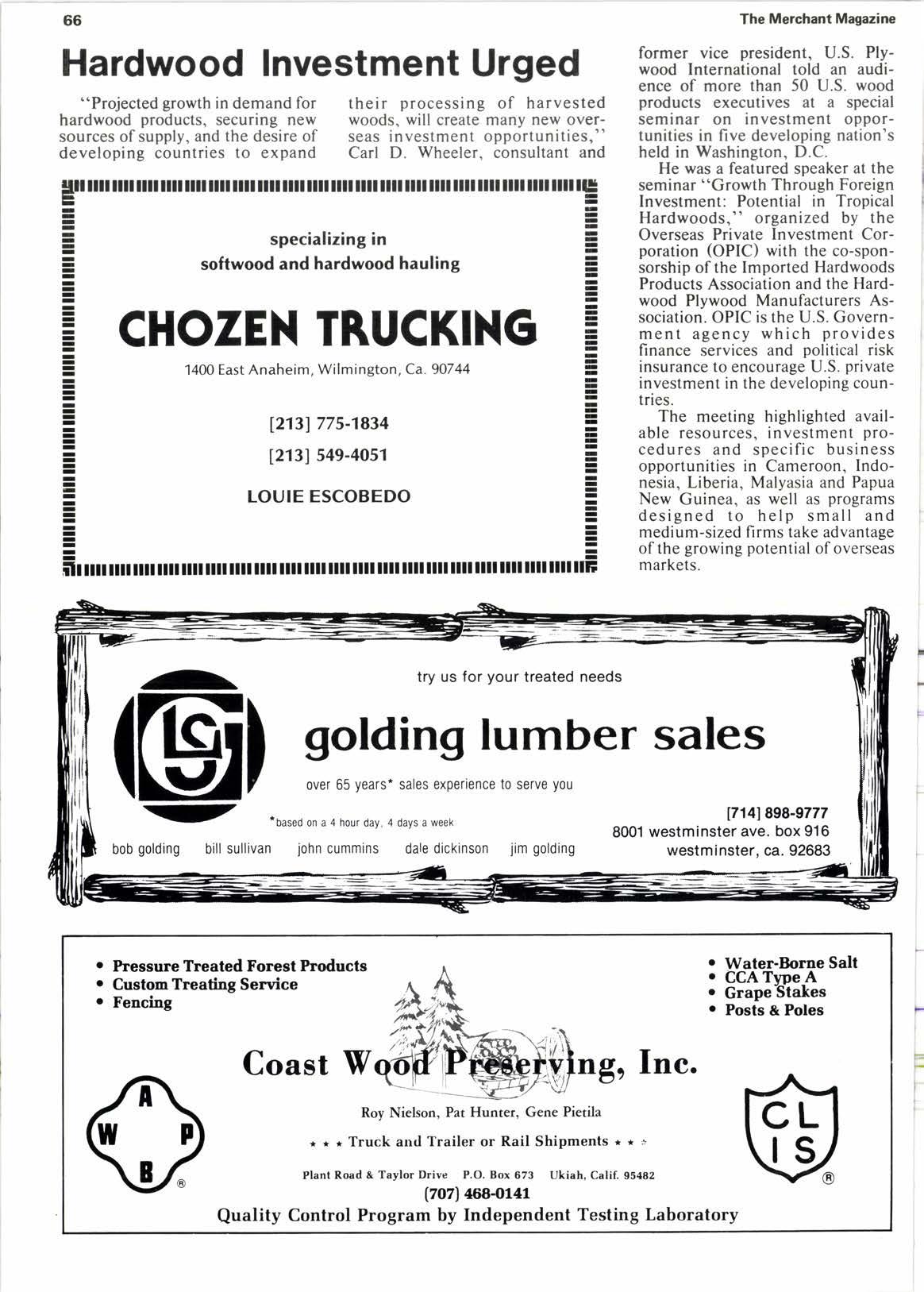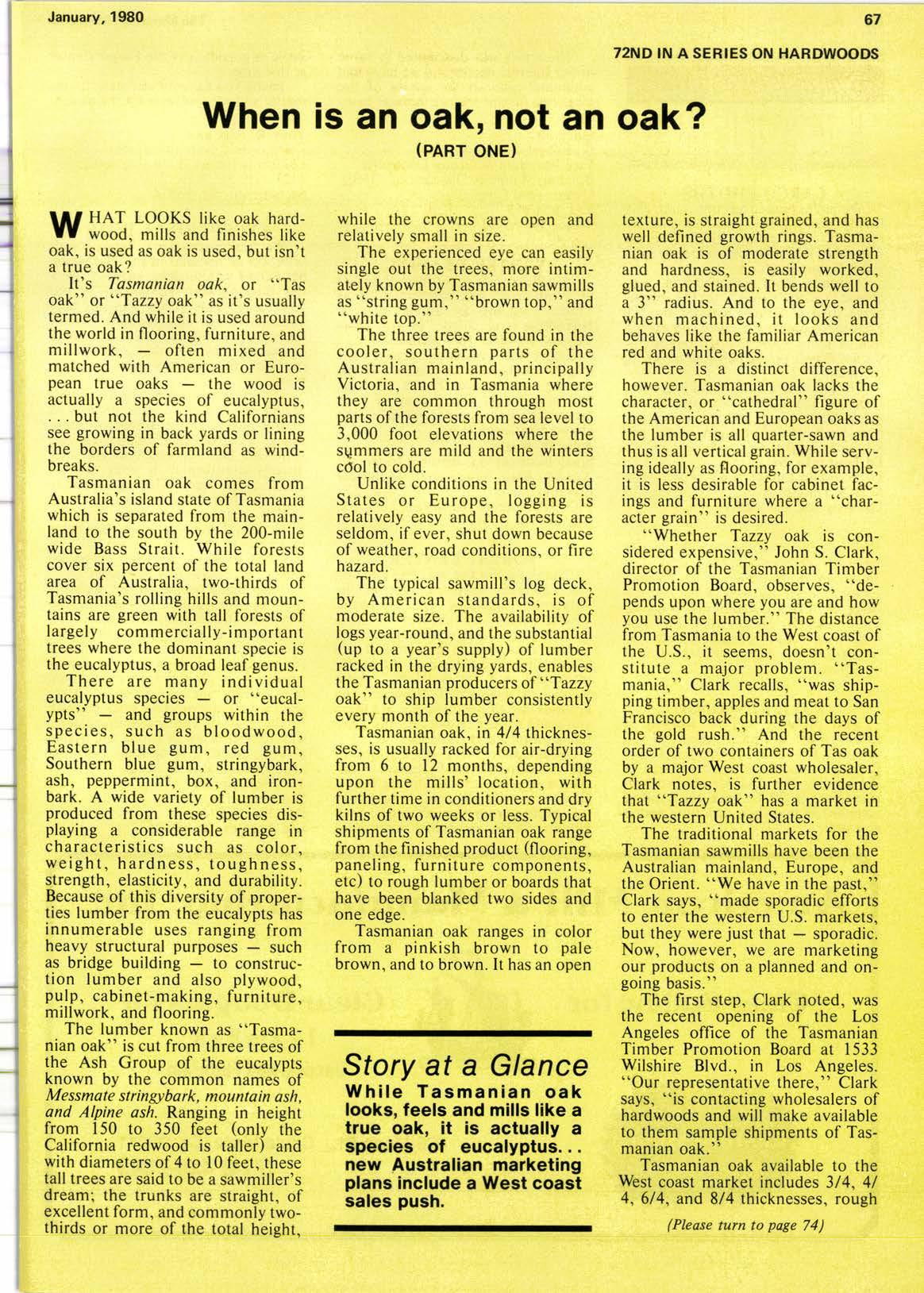
4 minute read
Hardwood Investment Urged
"Projected growth in demand for hardwood products, securing new sources of supply, and the desire of developing countries to expand their processing of harvested woods, will create many new overseas investment opportunities,"
Carl D. Wheeler,
consultant and former vice president, U.S. Plywood International told an audience of more than 50 U.S. wood products executives at a special seminar on investment opportunities in five developing nation's held in Washington, D.C.
He was a featured speaker at the seminar "Growth Through Foreign Investment: Potential in Tropical Hardwoods," organized by the Overseas Private Investment Corporation (OPIC) with the co-sponsorship of the Imported Hardwoods Products Association and the Hardwood Plywood Manufacturers Association. OPIC is the U.S. Government agency which provides finance services and political risk insurance to encourage U.S. private investment in the developing countries.
The meeting highlighted available resources, investment procedures and specific business opportunities in Cameroon, Indonesia, Liberia, Malyasia and Papua New Guinea, as well as programs designed to help small and medium-sized firms take advantage of the growing potential of overseas markets.
When is an oak, not an oak?
(PART ONE) llt HAT LOOKS like oak hard- ll wood. mills and finishes like oak, is used as oak is used, but isn't a true oak?
It's Tasmanian oak, or "Tas oak" or "Tazzy oak" as it's usually termed. And while it is used around the world in flooring, furniture, and millwork. often mixed and matched with American or European true oaks the wood is actually a species of eucalyptus, but not the kind Californians see growing in back yards or lining the borders of farmland as windbreaks.
Tasmanian oak comes from Australia's island state of Tasmania which is separated from the mainland to the south by the 200-mile wide Bass Strait. While foresrs cover six percent of the total land area of Australia, two-thirds of Tasmania's rolling hills and mountains are green with tall forests of largely commercially-important trees where the dominant specie is the eucalyptus, a broad leaf genus.
There are many individual eucalyptus speciesor "eucalypts" and groups within the species, such as bloodwood, Eastern blue gum, red gum, Southern blue gum, stringybark, ash, peppermint, box, and ironbark. A wide variety of lumber is produced from these species displaying a considerable range in characteristics such as color. weight, hardness, toughness, strength, elasticity, and durability. Because of this diversity of properties lumber from the eucalypts has innumerable uses ranging from heavy structural purposessuch as bridge buildingto construction lumber and also plywood, pulp, cabinet-making, furniture, millwork, and flooring.
The lumber known as "Tasmanian oak" is cut from three trees of the Ash Group of the eucalypts known by the common names of Messmate stringybark, mounta in ash, and Alpine asft. Ranging in height from 150 to 350 feet (only the California redwood is taller) and with diameters of 4 to 10 feet, these tall trees are said to be a sawmiller's dream; the trunks are straight, of excellent form, and commonly twothirds or more of the total height, while the crowns are open and relatively small in size.
The experienced eye can easily single oul the trees. more intimately known by Tasmanian sawmills as "string gum," "brown top," and "white top."
The three trees are found in the cooler, southern parts of the Australian mainland, principally Victoria, and in Tasmania where they are common through most parts ofthe forests from sea level to 3.000 foot elevations where the sUmmers are mild and the winters cdol to cold.
Unlike conditions in the United States or Europe, logging is relatively easy and the forests are seldom. if ever. shut down because of weather, road conditions, or fire hazard.
The typical sawmill's log deck, by American standards, is of moderate size. The availability of logs year-round, and the subslantial (up to a year's supply) of lumber racked in the drying yards, enables the Tasmanian producers of "Tazzy oak" to ship lumber consistently every month of the year.
Tasmanian oak, in 4/4 thicknesses, is usually racked for air-drying from 6 to 12 months, depending upon the mills'location, with further time in conditioners and dry kilns of two weeks or less. Typical shipments of Tasmanian oak range from the finished product (flooring, paneling, furniture components, etc) to rough lumber or boards that have been blanked two sides and one edge.
Tasmanian oak ranges in color from a pinkish brown to pale brown, and to brown. It has an open
Story at a Glance
While Tasmanian oak looks, feels and mills like a true oak, it is actually a species of eucalyptus. new Australian marketing plans include a West coast sales push.
texture, is straight grained, and has well defined growth rings. Tasmanian oak is of moderate strength and hardness, is easily worked, glued, and stained. It bends well to a 3" radius. And to the eye, and when machined, it looks and behaves like the familiar American red and white oaks.
There is a distinct difference, however. Tasmanian oak lacks the character, or "cathedral" figure of the American and European oaks as the lumber is all quarter-sawn and thus is all vertical grain. While serving ideally as flooring, for example, it is less desirable for cabinet facings and furniture where a "character grain" is desired.
"Whether Tazzy oak is considered expensive," John S. Clark, director of the Tasmanian Timber Promotion Board, observes, "depends upon where you are and how you use the lumber." The distance from Tasmania to the West coast of the U.S., it seems, doesn't constitute a major problem. "Tasmania," Clark recalls, "was shipping timber, apples and meat to San Francisco back during the days of the gold rush." And the recent order of two containers of Tas oak by a major West coast wholesaler, Clark notes, is further evidence thal "Tazzy oak" has a market in the western United States.

The traditional markets for the Tasmanian sawmills have been the Australian mainland, Europe, and the Orient. "We have in the past," Clark says, "made sporadic efforts to enter the western U.S. markets. but they were just that - sporadic. Now, however, we are marketing our products on a planned and ongoing basis."
The first step, Clark noted, was the recent opening of the Los Angeles office of the Tasmanian Timber Promotion Board at 1533 Wilshire Blvd., in Los Angeles. "Our representative there," Clark says, "is contacting wholesalers of hardwoods and will make available to them sample shipments of Tasmanian oak."
Tasmanian oak available to the West coast market includes 3/4, 4/ 4, 6/4. and 8/4 thicknesses, rough
(Please turn to page 74)










